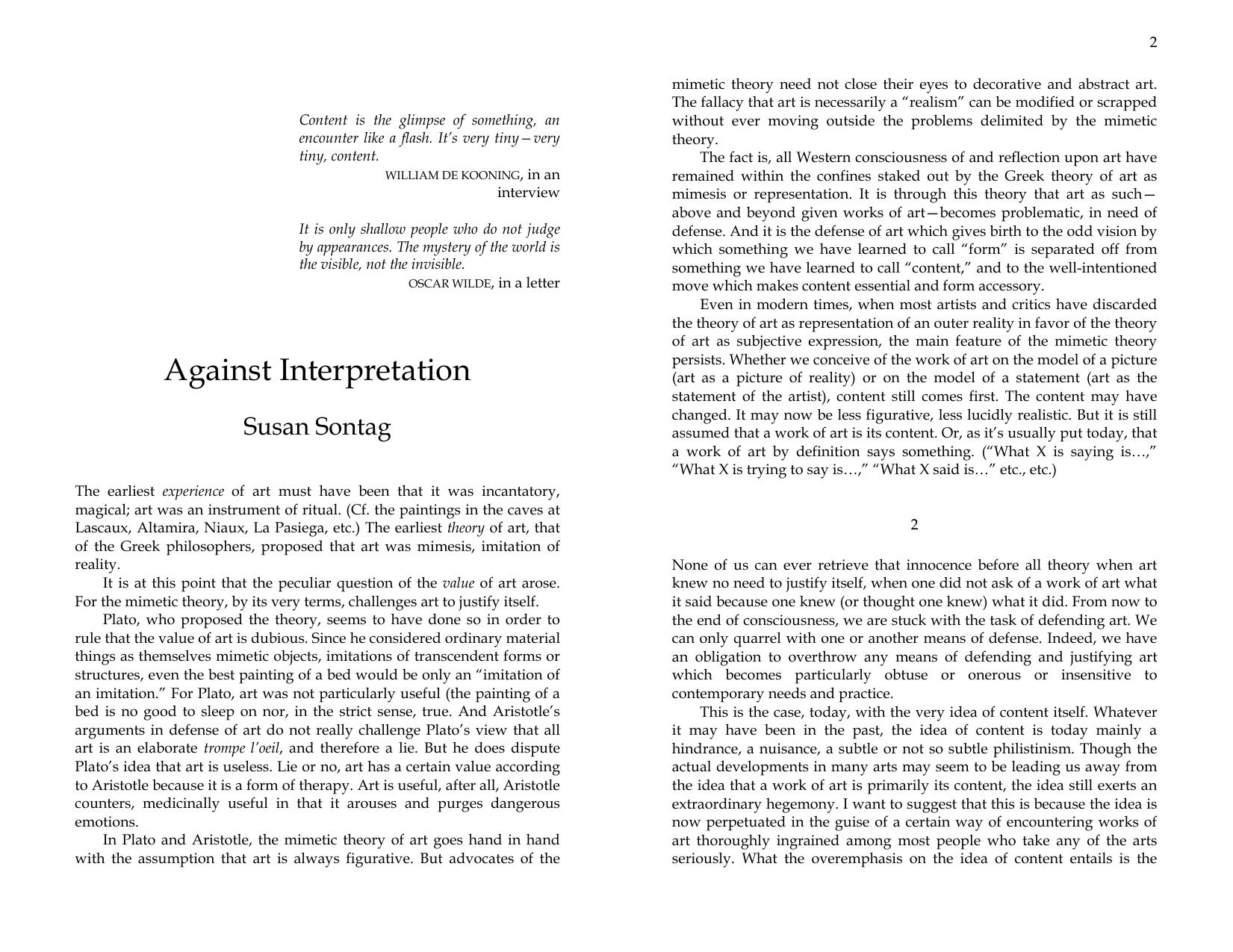Against Interpretation by Susan Sontag

Author:Susan Sontag
Language: eng
Format: epub, mobi, pdf
Publisher: Farrar, Straus and Giroux
“The Primary and most beautiful of Nature’s qualities is motion, which agitates her at all times. But this motion is simply the perpetual consequence of crimes; and it is conserved by means of crimes alone.”
SADE
“Everything that acts is a cruelty. It is upon this idea of extreme action, pushed beyond all limits, that theatre must be rebuilt.”
ARTAUD
Marat/Sade/Artaud
THEATRICALITY and insanity—the two most potent subjects of the contemporary theater—are brilliantly fused in Peter Weiss’ play, The Persecution and Assassination of Marat as Performed by the Inmates of the Asylum at Charenton under the Direction of the Marquis de Sade. The subject is a dramatic performance staged before the audience’s eyes; the scene is a madhouse. The historical facts behind the play are that in the insane asylum just outside Paris where Sade was confined by order of Napoleon for the last eleven years of his life (1803–14), it was the enlightened policy of the director, M. Coulmier, to allow Charenton’s inmates to stage theatrical productions of their own devising which were open to the Parisian public. In these circumstances Sade is known to have written and put on several plays (all lost), and Weiss’ play ostensibly re-creates such a performance. The year is 1808 and the stage is the stark tiled bathhouse of the asylum.
Theatricality permeates Weiss’ cunning play in a peculiarly modern sense: most of Marat/Sade consists of a play-within-a-play. In Peter Brook’s production, which opened in London last August, the aged, disheveled, flabby Sade (acted by Patrick Magee) sits quietly on the left side of the stage—prompting (with the aid of a fellow-patient who acts as stage manager and narrator), supervising, commenting. M. Coulmier, dressed formally and wearing some sort of honorific red sash, attended by his elegantly dressed wife and daughter, sits throughout the performance on the right side of the stage. There is also an abundance of theatricality in a more traditional sense: the emphatic appeal to the senses with spectacle and sound. A quartet of inmates with string hair and painted faces, wearing colored sacks and floppy hats, sing sardonic loony songs while the action described by the songs is mimed; their motley getup contrasts with the shapeless white tunics and strait-jackets, the whey-colored faces of most of the rest of the inmates who act in Sade’s passion play on the French Revolution. The verbal action, conducted by Sade, is repeatedly interrupted by brilliant bits of acting-out performed by the lunatics, the most forceful of which is a mass guillotining sequence, in which some inmates make metallic rasping noises, bang together parts of the ingenious set, and pour buckets of paint (blood) down drains, while other madmen gleefully jump into a pit in the center of the stage, leaving their heads piled above stage level, next to the guillotine.
In Brook’s production, insanity proves the most authoritative and sensuous kind of theatricality. Insanity establishes the inflection, the intensity of Marat/Sade, from the opening image of the ghostly inmates who are to act in Sade’s play, crouching in foetal
Download
Against Interpretation by Susan Sontag.mobi
Against Interpretation by Susan Sontag.pdf
This site does not store any files on its server. We only index and link to content provided by other sites. Please contact the content providers to delete copyright contents if any and email us, we'll remove relevant links or contents immediately.
| African | Asian |
| Australian & Oceanian | Canadian |
| Caribbean & Latin American | European |
| Jewish | Middle Eastern |
| Russian | United States |
4 3 2 1: A Novel by Paul Auster(12264)
The handmaid's tale by Margaret Atwood(7663)
Giovanni's Room by James Baldwin(7164)
Asking the Right Questions: A Guide to Critical Thinking by M. Neil Browne & Stuart M. Keeley(5606)
Big Magic: Creative Living Beyond Fear by Elizabeth Gilbert(5585)
Ego Is the Enemy by Ryan Holiday(5271)
The Body: A Guide for Occupants by Bill Bryson(4955)
On Writing A Memoir of the Craft by Stephen King(4848)
Ken Follett - World without end by Ken Follett(4621)
Adulting by Kelly Williams Brown(4467)
Bluets by Maggie Nelson(4460)
Eat That Frog! by Brian Tracy(4412)
Guilty Pleasures by Laurell K Hamilton(4346)
The Poetry of Pablo Neruda by Pablo Neruda(4021)
Alive: The Story of the Andes Survivors by Piers Paul Read(3956)
White Noise - A Novel by Don DeLillo(3943)
Fingerprints of the Gods by Graham Hancock(3926)
The Book of Joy by Dalai Lama(3884)
The Bookshop by Penelope Fitzgerald(3764)
